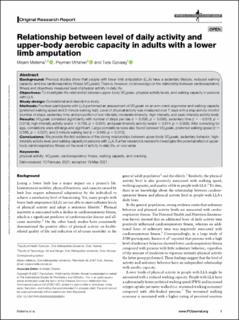| dc.contributor.author | Mellema, Mirjam | |
| dc.contributor.author | Mirtaheri, Peyman | |
| dc.contributor.author | Gjøvaag, Terje | |
| dc.date.accessioned | 2021-09-28T07:08:00Z | |
| dc.date.available | 2021-09-28T07:08:00Z | |
| dc.date.created | 2021-07-24T11:50:23Z | |
| dc.date.issued | 2021-08 | |
| dc.identifier.issn | 0309-3646 | |
| dc.identifier.issn | 1746-1553 | |
| dc.identifier.uri | https://hdl.handle.net/11250/2783902 | |
| dc.description.abstract | Background: Previous studies show that people with lower limb amputation (LLA) have a sedentary lifestyle, reduced walking capacity, and low cardiorespiratory fitness (VO2peak). There is, however, no knowledge on the relationship between cardiorespiratory fitness and objectively measured level of physical activity in daily life. Objectives: To investigate the relationship between upper-body VO2peak, physical activity levels, and walking capacity in persons with LLA. Study design: Correlational and descriptive study. Methods: Fourteen participants with LLA performed an assessment of VO2peak on an arm-crank ergometer and walking capacity (preferred walking speed and 2-minute walking test). Level of physical activity was measured over 7 days with a step activity monitor (number of steps; sedentary time; and proportion of low-intensity, moderate-intensity, high-intensity, and peak-intensity activity level). Results: VO2peak correlated significantly with number of steps per day (r = 0.696, p = 0.006), sedentary time (r = −0.618, p = 0.019), high-intensity activity level (r = 0.769, p = 0.001), and peak-intensity activity level (r = 0.674, p = 0.008). After correcting for age, correlations were still large and significant. Large correlations were also found between VO2peak, preferred walking speed (r = 0.586, p = 0.027), and 2-minute walking test (r = 0.649, p = 0.012). Conclusions: We provide the first evidence of the strong relationships between upper-body VO2peak, sedentary behavior, high-intensity activity level, and walking capacity in persons with LLA. Further research is needed to investigate the potential effect of upper-body cardiorespiratory fitness on the level of activity in daily life, or vice versa. | en_US |
| dc.description.sponsorship | This work was financially supported by the Research Council of Norway and Oslo Metropolitan University/Faculty of Technology, Art, and Design/Faculty of Health Sciences. The funded project is “Patient-Centric Engineering in Rehabilitation (PACER)” and project No. is 273599. | en_US |
| dc.language.iso | eng | en_US |
| dc.publisher | Lippincott, Williams & Wilkins | en_US |
| dc.relation.ispartofseries | Prosthetics and orthotics international;August 2021 - Volume 45 - Issue 4 | |
| dc.rights | Navngivelse-Ikkekommersiell 4.0 Internasjonal | * |
| dc.rights.uri | http://creativecommons.org/licenses/by-nc/4.0/deed.no | * |
| dc.subject | Physical activities | en_US |
| dc.subject | VO2 peaks | en_US |
| dc.subject | Cardiorespiratory fitness | en_US |
| dc.subject | Walking capacity | en_US |
| dc.subject | Arm cranking | en_US |
| dc.title | Relationship between level of daily activity and upper-body aerobic capacity in adults with a lower limb amputation | en_US |
| dc.type | Peer reviewed | en_US |
| dc.type | Journal article | en_US |
| dc.description.version | publishedVersion | en_US |
| dc.rights.holder | Copyright © 2021 The Authors. | en_US |
| cristin.ispublished | true | |
| cristin.fulltext | original | |
| cristin.qualitycode | 1 | |
| dc.identifier.doi | https://doi.org/10.1097/PXR.0000000000000024 | |
| dc.identifier.cristin | 1922539 | |
| dc.source.journal | Prosthetics and orthotics international | en_US |
| dc.source.volume | 45 | en_US |
| dc.source.issue | 4 | en_US |
| dc.source.pagenumber | 343-349 | en_US |
| dc.relation.project | Norges forskningsråd: 273599 | en_US |

